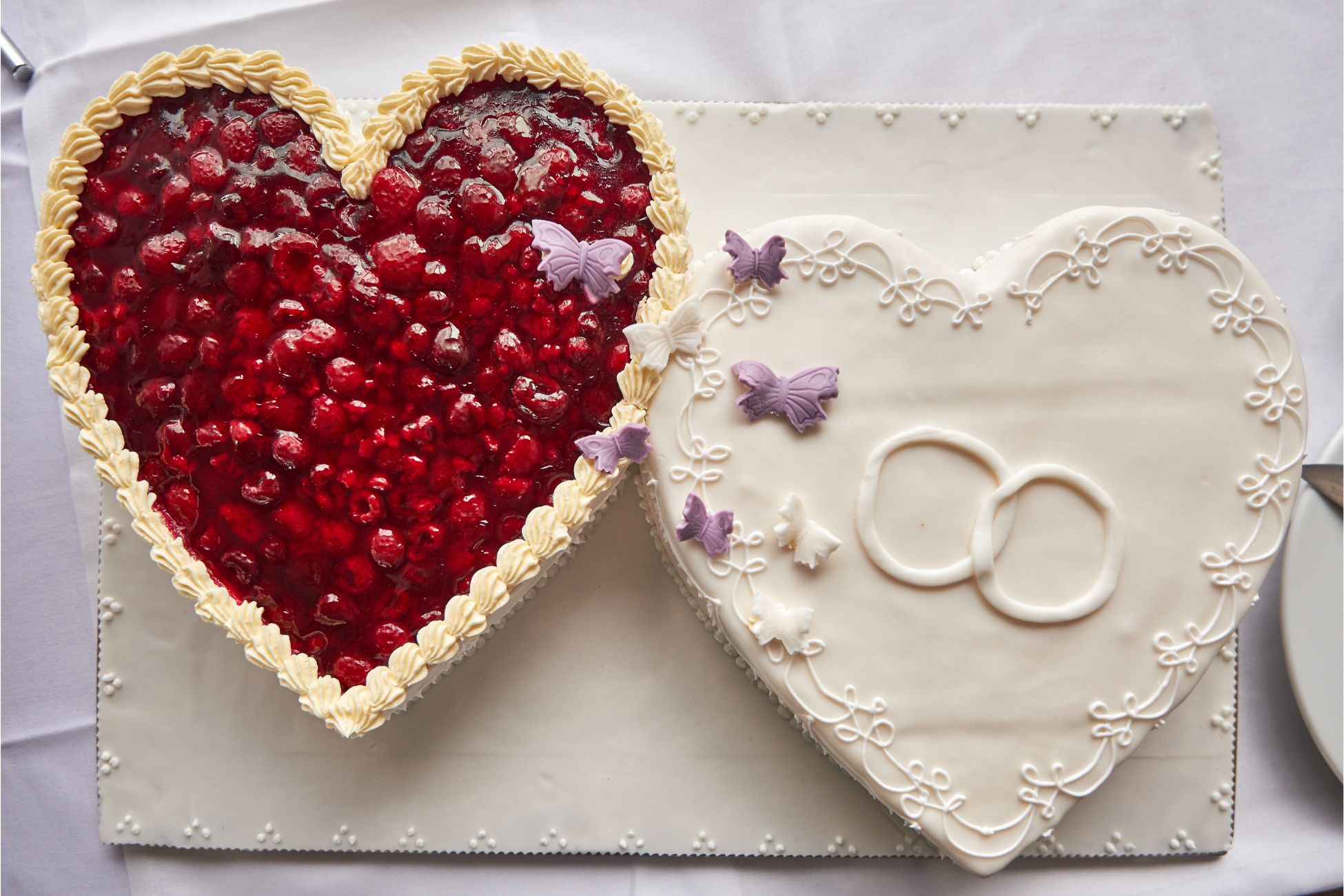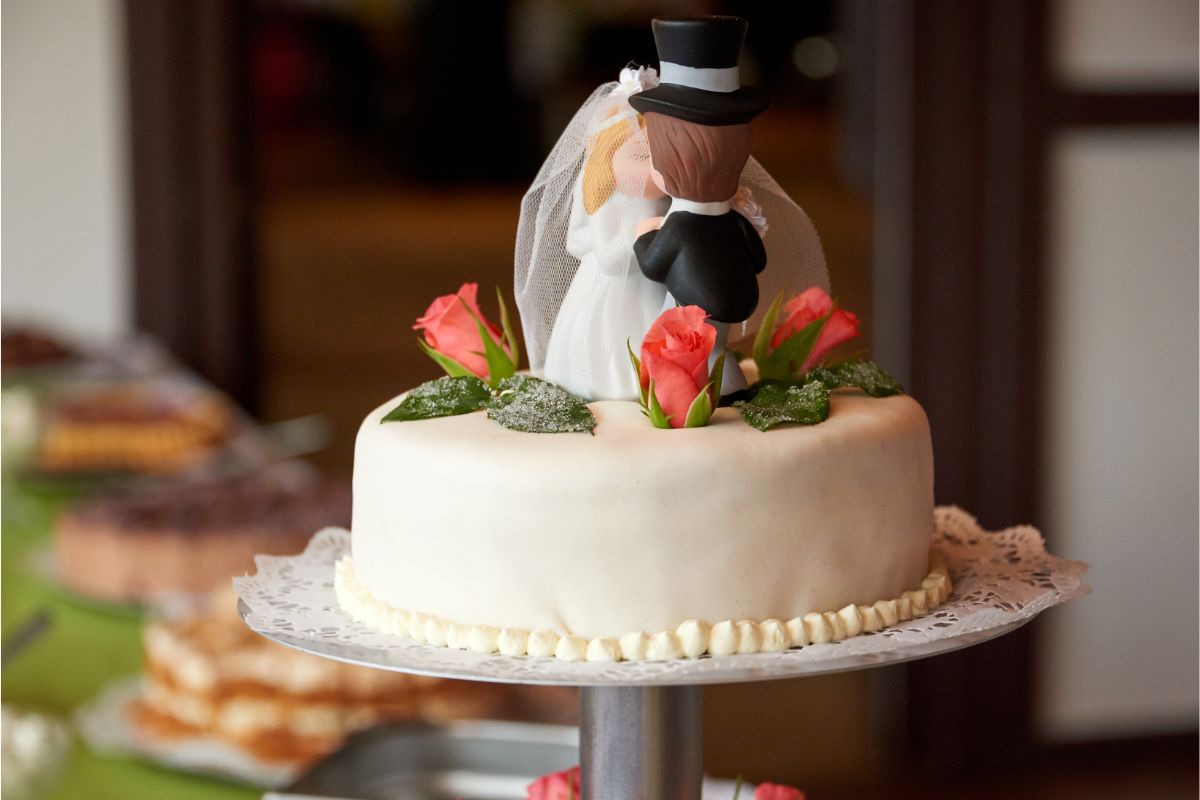It’s no secret that weddings are all about tradition, and it seems like each minute facet of the whole process is laden with intricate details, meanings, and practices.

While these will certainly differ throughout the world – particularly in non-Christian countries and territories – there are certain traditions in the western world that continue to work their way into modern matrimony.
One example of this is with the idea of wedding cakes. But what exactly is a traditional wedding cake, (see also: Putting Your Wedding Cake Under Your Pillow: What Is This Tradition?)and what are the meanings behind it?
What Is A ‘Traditional’ Wedding Cake?
Generally speaking, the idea of a ‘traditional’ wedding cake in the western, Christian world, consists of a tiered, usually white cake, consisting of either a fruit cake filling, or a cream filling served with a layer of red jelly or jam.
While this is considered the ‘ideal’ within many parts of the western world – namely the United Kingdom and parts of the US – the notion of what is and isn’t traditional is rarely considered in modern ceremonies, or at least not in the way that it once was.
Where Did The Wedding Cake Originate?
While the exact origin of the wedding cake is not known for certain, many experts and historians suspect that it probably originated in Ancient Greece – with the proceeding traditions being an amalgamation of cultures and religions from all around the world.
For example, one tradition for the wedding cake was established in Ancient Rome – where a cake made from wheat and barley would be made, and then broken over the bride’s head for good luck.
What Are Some Traditions Surrounding Wedding Cakes?
When it comes down to the actual meaning of the wedding cake itself, this is obviously something that differs depending on religion, country, and in many cases, the traditions of each individual family.
However, there are several meanings that transcend many of these cultural differences.
16th Century Europe
In Europe during the 16th and 17th centuries, a baking tradition known as the ‘bride’s pie’ was the common dish served at wedding receptions. These were savory, and differed greatly from what would now be considered a wedding cake.
These would generally be made from oysters, lamb’s testicles, pine kernels, and cocks combs – and most would often contain a hollow compartment with live birds or a snake as entertainment for the guests attending the ceremony.
The whole meaning behind the dish came from one of ‘good luck’, and it was considered not only beneficial, but also respectful for all the guests to try a piece of the pie.
They would also usually be baked with a glass ring somewhere inside, with the first woman to find one being the next one to get married.
This is the same as the modern tradition of the bride throwing the bouquet over her shoulder – wherein the woman to catch it will be the (predicted) next one to get married.
English Traditions
Things in England were a little different, and perhaps represented a more closer view to what we see in matrimony today.
In medieval England, wedding cakes (at least amongst the wealthy) were constructed to be as high as possible, with the point being for the bride and groom to attempt a successful kiss over the top of the cake.
If they managed this, they would be guaranteed a successful, long, and happy marriage.
This would generally not be one whole cake, but would instead be piled sweet rolls, formed in a pyramid or conical shape to try and reach as big a height as possible.
This would give rise to the croquembouche, when a French pastry chef visited medieval England and observed the practice firsthand.
What Does The Cake Symbolize?
As you can imagine, this long and storied history of wedding cakes means that there have been several meanings and symbolism placed upon the dish over the years.
Good Luck
One of the most notable and enduring pieces of symbolism surrounding wedding cakes is the idea of good luck.

This began with everyone sampling a piece of the cake as a way of group accepting the nuptials and giving the couple their blessings and good will. This also frequently served as good luck for the romantic lives of the guests too.
Over time, this turned into more of a gesture of goodwill and thanks, and it is now still common in many countries for guests to receive a piece of wedding cake during the reception.
Purity/Virginity
Just like the wedding dress, the wedding cake has long been white in color – at least since the invention of white icing.
This color was often associated with purity and virginity, and was perpetuated notably during the wedding of Queen Victoria and Prince Albert in 1840.
This made the notion of white weddings, as well as their associated themes and symbolism, especially popular within western society during the ensuing centuries.
Even today, the idea of a white wedding dress and cake are considered to be signs of purity – even though such ideas are generally considered outdated.
Respect
The idea of cutting the cake, particularly the order in which it is cut and given out to guests, is laden with important symbolism.
In China, cutting the wedding cake is very important, and it is often cut from the bottom, wherein the first pieces are given to the parents as a sign of respect – not to mention symbolizing their position as the foundation of the familial unit.
Are There Any Superstitions?
Due to their association with good luck and prosperity, the wedding cake has also become associated with numerous different traditions.
Cakes Under The Pillow
Traditionally, bridesmaids with their own dreams of getting married would take a piece of the cake home with them and keep it under their pillows to manifest their own special day in the future.
Passing Through Wedding Ring
Bridesmaids would also pass the cake through the bride’s wedding ring, as a way of giving themselves good luck for their future nuptials.
Other Notable Traditions
There are also some traditions that seem to be the same the world over.
The Height
Tall, tiered cakes are common around the world, and in many different religions this is generally seen as a sign of the stability and strong foundations of the marriage in question.
The taller and sturdier the cake, the better the marriage would fare.
Decorations
Decorations are another frequent, recurring tradition, and are often used to represent the couple – i.e. in the form of a topper (small figurines) – or as a depiction of their journey through life and their family history.
Final Thoughts
And there we have it, everything you need to know about traditional wedding cakes, and the traditions that go along with them.
It’s true that wedding celebrations are laden with various traditions, many of which vary from country to country, and region to region.
However, when it comes to Christian wedding cakes in the western world, there are certain traditions that have continued to the present day, and continue to be staples of the whole event.
- How To Make Honey Butter - July 4, 2023
- How To Make Meringue - July 3, 2023
- What Is Shortening? - July 3, 2023









Leave a comment